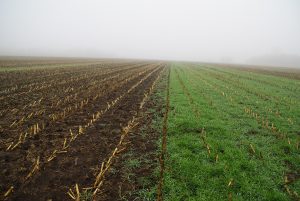When I left the house this morning, I exhaled in the last rays of moonlight and gazed as the mist of my breath dissipated in the gentle breeze. I was cold and grateful. I was grateful that I had everything I need to survive the morning in that frigid air. I had a full belly of the morning’s breakfast. I was well hydrated. I was breathing the oxygen rich morning air. And, I was clothed in the heavy winter sweater I recently pulled from summer storage. The organism of my body was supported. But, then, I turned my head and witnessed a heartbreaking view of the all-too-common autumn sight of bare soil stretching for hundreds of acres.
 Just as the organism of my body requires support to survive and thrive, so too does the organism of the soil. The soil is a complex ecosystem that needs plants and the shelter they provide. The solution to bare soil in the off-season is winter cover crops. There are many options available that can be tailored to the needs of any particular soil. Some cover crops, like tillage radishes, help break up compaction. Some, like red clover, build nitrogen. Others, like rye or oats, suppress weed seed germination. But, they all have some benefits in common, they reduce soil erosion and build soil organic matter.
Just as the organism of my body requires support to survive and thrive, so too does the organism of the soil. The soil is a complex ecosystem that needs plants and the shelter they provide. The solution to bare soil in the off-season is winter cover crops. There are many options available that can be tailored to the needs of any particular soil. Some cover crops, like tillage radishes, help break up compaction. Some, like red clover, build nitrogen. Others, like rye or oats, suppress weed seed germination. But, they all have some benefits in common, they reduce soil erosion and build soil organic matter.
Cover crops are generally sown immediately after harvest. To get the best stand, they need some lead time before the first frost. With our warm fall this year, it’s not too late to get your cover crop in the field. Your soil, the Earth, and future generations of farmers will thank you.
Some more cover crop information:
- Managing Cover Crops Profitably (pdf publication by SARE, very comprehensive)
- Cover Crop Presentation (pdf chart with associated information about each species)
- Cover Crop Chart (very comprehensive chart of crops and their benefits)


